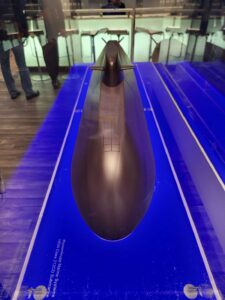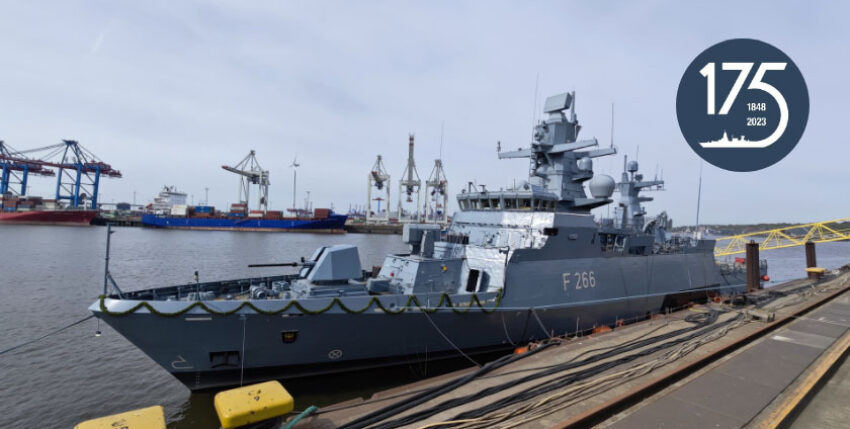To mark its 175th birthday, the German Navy is giving itself a new target image. However, there are just as many problems as there are good ideas.
In the 175th anniversary year of the German Navy, the inspector of the navy is looking ahead with the publication of its future structure. Vice Admiral Jan C. Kaack said in an interview with Kieler Nachrichten: "In the 2035+ target picture, we want to open up a big bouquet." He is not talking about flagpoles. Rather, he wants the navy to remain fit for the future.
This all takes place in view of the dramatic changes since the invasion of Ukraine by Russian forces. The focus is on the return to national and alliance defence as well as the effects of Finland's (and probably soon Sweden's) accession to NATO on the deployment of forces in the Baltic Sea. Added to this is the foreseeable intensification of problems in recruiting personnel due to demographic upheavals, which has led to the decision in favour of a broad introduction of unmanned systems.

Kaack is inspector
the navy
However, the navy already has a lot of experience with unmanned systems. After all, it has been operating remote-controlled SEEHUND-class hollow-barrelled sweepers since 1981. They were successfully deployed in the Persian Gulf during Operation South Flank in 1991. The Seefuchs underwater drone, also known internationally as SeaFox, is not only used by the German Navy, but also by ten partners.
In addition to reducing the risk to life and limb, autonomous systems have the advantage that fewer personnel are required. The deficit in personnel development has long been a source of concern for the navy. The long-term average personnel shortfall is around twelve per cent. However, personnel recruitment cannot even come close to fulfilling expectations. In the 2035+ target scenario, the Navy is attempting to address the personnel situation by utilising modern technology, reducing the fleet by one frigate 125 and subtly moving away from the multi-crew concept. Overall, the potential savings from these measures amount to up to 1,500 personnel. However, this does not mean that the navy's personnel requirements will be reduced. Rather, it will create capacities that can be used for new tasks, including the intelligent control of autonomous naval warfare assets.
On the way to a "threat-appropriate and demographically resilient navy", Kaack had "a sufficient number of ships and boats, aircraft and helicopters to ensure a sustainable presence in the operational areas" included in the navy's target image from 2035.
He is alluding less to the number and more to the availability of naval assets. "Our goal is 'Route 66' - we want to have 66 per cent of the units ready for sea," postulates the naval chief. And so the target structure from 2035 includes the consistent application of the 3-to-1 rule, according to which one third of the flying, floating and diving units are to be in maintenance, one third in graduated and one third in full combat readiness. This means that three units must be kept available for each unit in action.
The expected modernisation push will not only be expressed through the planned autonomous systems or adaptations to modern situational awareness and command and control capabilities. It will go beyond the future Naval Combat Cloud, in which manned, optionally manned and unmanned systems will be networked. The Navy wants to establish a maritime technology centre with a possible location in Eckernförde. Vice Admiral Kaack is talking about a Task Force X-Ray, which will be responsible for experiments and prototypes. This experimental facility is intended to create the conditions for integrating new systems into operations. At the same time, it will enable further technical and operational development.

future
Class U 212CD, photo: hum
The navy also wants to break new ground with the successors to the Class 404 tender. Until now, they were planned as simple support vehicles. According to the 2035+ target vision, the future support platforms should not only be able to supply boat formations. Their extended range of capabilities includes supply at sea, drone deployment (e.g. as drone mother ships), casualty transport and the deployment of infantry forces. A slimmed-down amphibious vehicle, if you like. In any case, modular platforms that can be adapted to their respective tasks.
Still a long way to go
With the target image, the Navy is attempting to position itself for the future. Several doors are being opened to this end. In addition to a larger and more powerful array of autonomous sea and air vehicles, multi-domain operations and other technological solutions can be recognised. Seabed warfare is also making inroads. Critical maritime infrastructure, explains Kaack in an interview with the FAZ, "is not the responsibility of the navy, but ultimately we are the only ones who can do something in this area. What we can do, however, is to supplement the proven surface situation picture with a network of underwater knowledge. This comes on the one hand from naval sensors and reconnaissance, and on the other from research and industry. There are many sonar buoys or sensors that are installed at every wind farm, for example, and constantly supply data. If you combine all of this, you could get a much more detailed picture."
In the target vision for the navy from 2035, the threat once again becomes the yardstick. Deterrence and defence in the North Atlantic, North Sea and Baltic Sea and their approaches are moving centre stage.
It looks like the navy is on the right track. However, the current situation is still not very rosy. "On 24 February 2022, I had 50 percent of the units ready for sea," Vice Admiral Kaack admitted to the Kieler Nachrichten newspaper. In the context of the target picture, a lot still needs to grow.
Hans-Uwe Mergener










